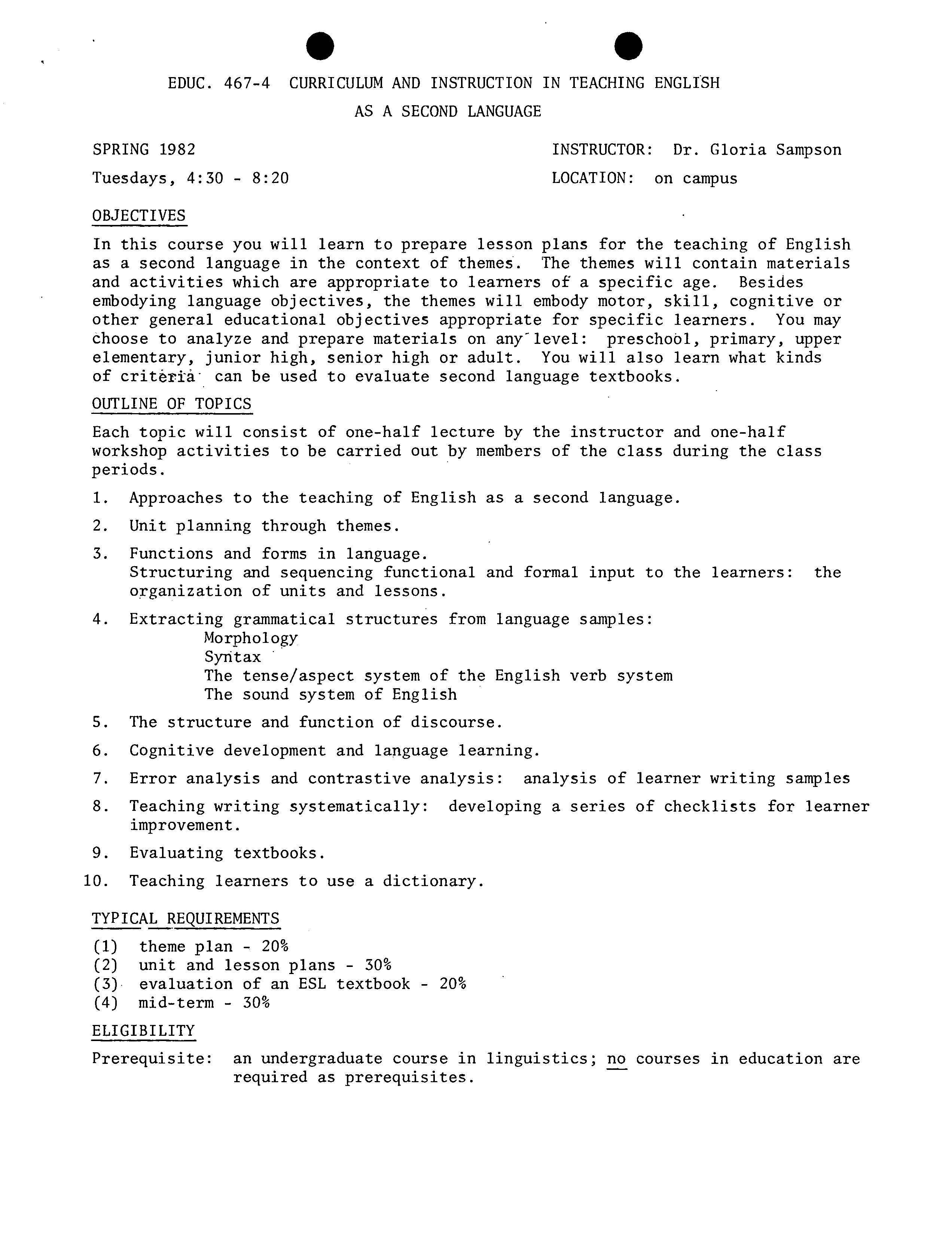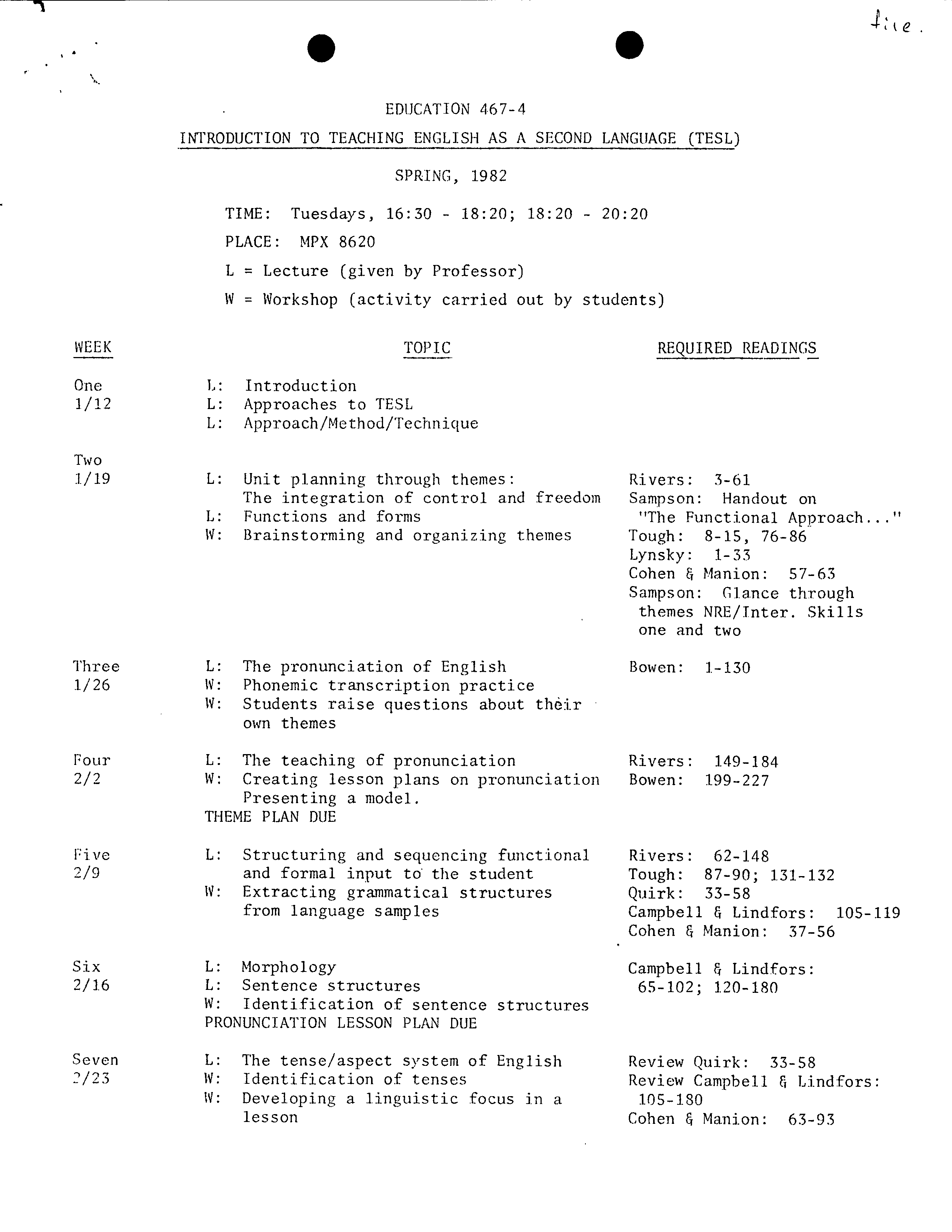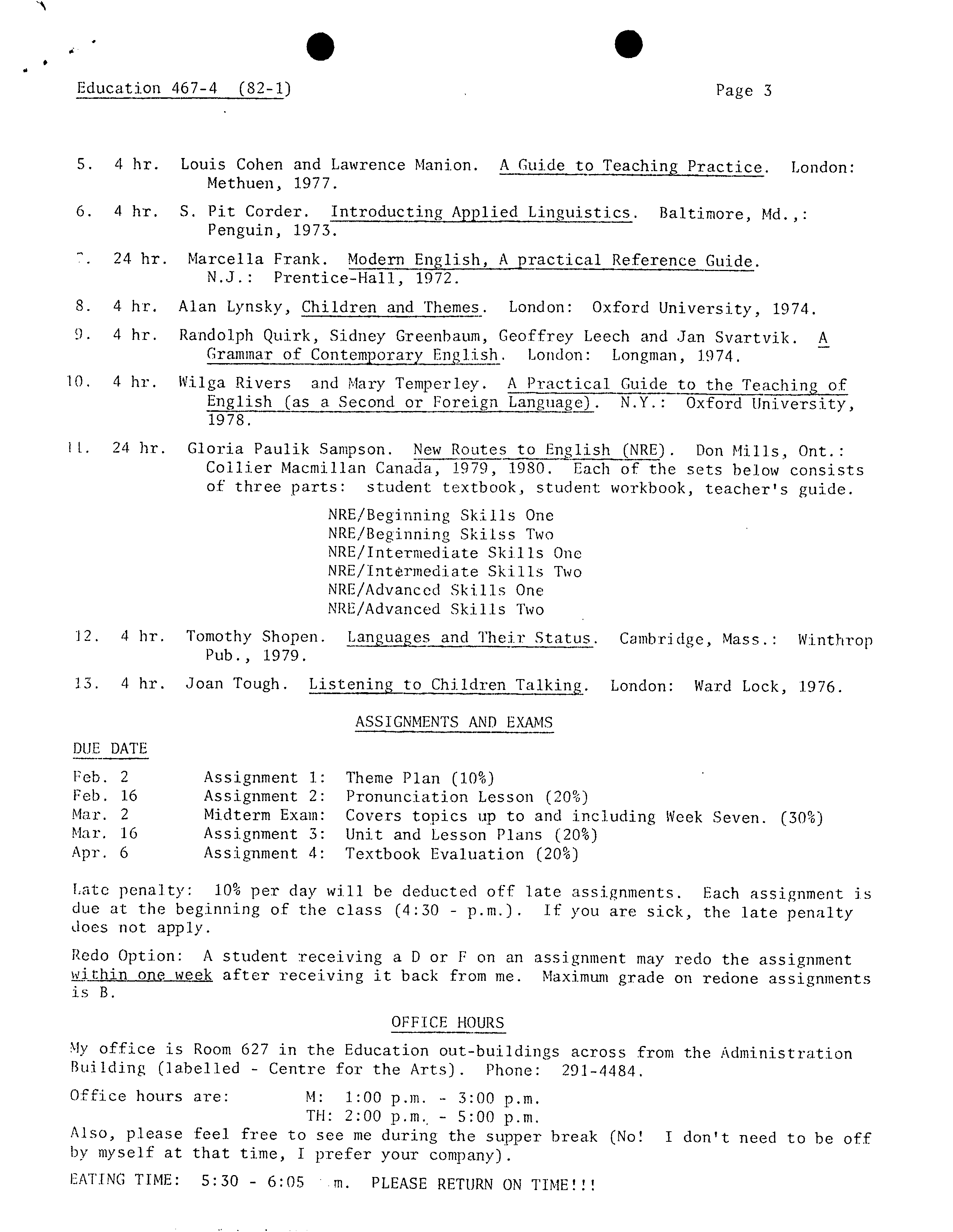.
?
.
EDUC. 467-4 CURRICULUM AND INSTRUCTION IN TEACHING ENGLISH?
AS A SECOND LANGUAGE
SPRING 1982 ?
INSTRUCTOR: Dr. Gloria Sampson
Tuesdays, 4:30 - 8:20
?
LOCATION: on campus
OBJECTIVES
In this course you will learn to prepare lesson plans for the teaching of English
as a second language in the context of themes. The themes will contain materials
and activities which are appropriate to learners of a specific age. Besides
embodying language objectives, the themes will embody motor, skill, cognitive or
other general educational objectives appropriate for specific learners. You may
choose to analyze and prepare materials on any level: preschool, primary, upper
elementary, junior high, senior high or adult. You will also learn what kinds
of criteria
'
can be used to evaluate second language textbooks.
OUTLINE OF TOPICS
Each topic will consist of one-half lecture by the instructor and one-half
workshop activities to be carried out by members of the class during the class
periods.
1.
Approaches to the teaching of English as a second language.
2.
Unit planning through themes.
3. Functions and forms in language.
Structuring and sequencing functional and formal input to the learners: the
organization of units and lessons.
4. Extracting grammatical structures from language samples:
Morphology
Syntax
The tense/aspect system of the English verb system
The sound system of English
S. The structure and function of discourse.
6.
Cognitive development and language learning.
7.
Error analysis and contrastive analysis: analysis of learner writing samples
8. Teaching writing systematically: developing a series of checklists for learner
improvement.
9. Evaluating textbooks.
10.
Teaching learners to use a dictionary.
TYPICAL REQUIREMENTS
(1)
theme plan - 20%
(2)
unit and lesson plans - 30%
(3) evaluation of an ESL textbook - 20%
(4)
mid-term - 30%
PTT(T1TT TTY
Prerequisite: an undergraduate course in linguistics; no courses in education are
required as prerequisites.
S ?
.
EDUCATION 467-4
INTRODUCTION TO TEACHING ENGLISH AS A SECOND LANGUAGE (TESL)
SPRING, 1982
TIME: Tuesdays, 16:30 - 18:20; 18:20 - 20:20
PLACE: MPX 8620
L
?
Lecture (given by Professor)
W = Workshop (activity carried out by students)
WEEK
?
TOPIC
?
REQUIRED READINGS
One
1/12
Two
:1./19
L: Introduction
L: Approaches to TESL
L: Approach/Method/Technique
L: Unit planning through themes:
The integration of control and freedom
L: Functions and forms
W: Brainstorming and organizing themes
Rivers: 3-61
Sampson: Handout on
'The Functional Approach..
Tough: 8-15, 76-86
Lynsky: 1-33
Cohen E
1
Manion: 57-63
Sampson: Glance through
themes NRE/Tnter. Skills
one and two
Three
L:
The pronunciation of English
Bowen:
1-130
1/26
W:
Phonemic transcription practice
W:
Students raise questions about thô:i.r
own themes
Four
L:
The teaching of pronunciation
Rivers:
149-184
2/2
W:
Creating lesson plans on pronunciation
Bowen:
199-227
Presenting a model.
THEME PLAN DUE
Five
L:
Structuring and sequencing functional
Rivers:
62-148
2/9
and formal input to the student
Tough:
87-90; ?
131-132
W:
Extracting grammatical structures
Quirk: 33-58
from language samples
Campbell
Lindfors:
?
105-119
Cohen
Manion:
?
37-56
Six ?
L: Morphology
?
Campbell F. Lindfors:
2/16
?
L: Sentence structures
?
65-102; 120-180
W: Identification of sentence structures
PRONUNCIATION LESSON PLAN DUE
Seven ?
L: The tense/aspect system of English
?
Review Quirk: 33-58
2/23 ?
IV: Identification of tenses
?
Review Campbell ?
Lindfors:
IV: Developing a linguistic focus in a
?
105-180
lesson
?
Cohen
?
Manion: 63-93
.
.
Education
467-4
(82-1)
Page 2
Eight
MIDTERM
3/2
L:
The structure and function of discourse
Rivers:
187-224
W:
Identifying audience, function and
Corder:
50-67
lexical domain
Brown:
189-207
Nine
L:
Cognitive development and language
3/9
learning
Rivers:
225-261
W:
Using Bloom's Taxonomy of Cognitive
Ojhectives: ?
creating good questions
Ten
L: Error analysis and contrastive analysis:
Rivers:
262-296
3/16
The teaching of writing
Corder:
224-294
and/or
UNIT AND LESSON PLANS DUE
Brown:
147-160;
162-186
Shopen:
295-313;
322-329
Eleven
L: Evaluating Textbooks
Rivers:
297-343
3/23
W: Implementing a lesson from a text
Corder: 295-322
Twelve
L: Evaluating textbooks
Allen
Campbell,
2nd ed.
3/30
W: Evaluating textbooks
101-112
Thirteen
L: Teaching Dictionary Use
Handout
zj /6
TEXTBOOKS TO PURCHASE
1.
(Required) Wilga Rivers and Mary Temperley. A Practical Guide to the Teaching
of English (as a Second or Foreign Language). N.Y.:
Oxford University Press, 1978.
2.
(Optional) J. Donald Bowen. Patterns of English Pronunciation. Rowley, Mass.
Newbury House, 1975.
3.
(Optional) Joan Tough. Listening to Children Talking. London: Ward Lock
Educ., 1976.
BOOKS ON RESERVE
1.
4 hr. Harold B. Allen and Russell Campbell. Teaching English as a Second
Language. N.Y.: McGraw Hill, 1972.
2.
4 hr. J. Donald Bowen. Patterns of English Pronunciation. Rowley, Mass.:
Newbury House, 1975.
3.
4 hr. H. Douglas Brown. Principles of LangugeTeaáhing and Learning. N.J.:
Prentice-Hall, 1980.
Li. 24 hr. Russell Campbell and Judith Lindfors. Insi
,
ghts into English Structure.
N.J. : Prentice-Hall, 1969.
S
?
[I
Education 467-4 (82-1
?
Page 3
S. 4 hr. Louis Cohen and Lawrence Manion. A Guide to Teaching Practice. London:
Methuen, 1977.
6. 4 hr. S. Pit Corder. Introducting Applied Linguistics. Baltimore, Md.,:
Penguin, 1973.
24 hr. Marcella Frank. Modern English, Aactical Reference Guide.
N.J.: Prentice-Hall, 1972.
8.
4 hr. Alan Lyrnsky, Children and Themes. London: Oxford University, 1974.
9.
4 hr. Randolph Quirk, Sidney Greenbaum, Geoffrey Leech and Jan Svartvik. A
Grammar of Contem orary English. London: Longman, 1974.
10.
4 hr. Wilga Rivers and Mary Temperley. A Practical Guide to the Teaching of
English (as a Second or Foreign Language). N.Y.: Oxford University,
1978.
I I. 24 hr. Gloria Paulik Sampson. New Routes to English (NRE) . Don Mills, Ont.
Collier Macmillan Canada, 1979, 1980. Each of the sets below consists
of three parts: student textbook, student workbook, teacher's guide.
NRE/Beginning Skills One
NRE/Beginning Skilss Two
NRE/Interrnedjate Skills One
NRE/Intrmediate Skills Two
NRE/Advanced Skills One
NRE/Advanced Skills Two
12.
4 hr. Tomothy Shopen. Languages and Their Status. Cambridge, Mass.: Winthrop
Pub., 1979.
13.
4 hr. Joan Tough. Listening to Children Talking. London: Ward Lock, 1976.
ASSIGNMENTS AND EXAMS
DUE DATE
Feb.
2
Assignment 1:
Theme Plan (10%)
Feb. 16
Assignment 2:
Pronunciation Lesson (20%)
Mar. 2
Midterm Exam:
Covers topics up to and including Week Seven.
?
(30%)
Mar.
16
Assignment 3:
Unit and Lesson Plans (20%)
Apr.
6
Assignment 4:
Textbook Evaluation (20%)
Late penalty: 10% per day will be deducted off late assignments. Each assignment is
due at the beginning of the class (4:30 - p.m.). If you are sick, the late penalty
does not apply.
Redo Option: A student :receiving a D or F on an assignment may redo the assignment
chin one week after receiving it back from me. Maximum grade on redone assignments
is B.
OFF-ICE HOURS
My
office is Room 627 in the Education out-buildings across from the Administration
Building (labelled - Centre for the Arts). Phone: 291-4484.
Office hours are:
?
M: ?
1:00 p.m. - 3:00 p.m.
TI-I: 2:00 p.m.
,
- 5:00 p.m.
Also, please feel free to see me during the supper break (No! I don't need to he off
by
myself at that time, I prefer your company).
EATING TIME: 5:30 - 6:05
?
rn. PLEASE RETURN ON TIME!!!




